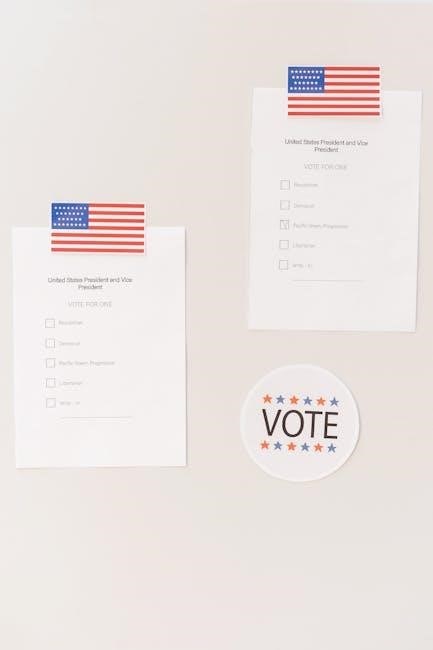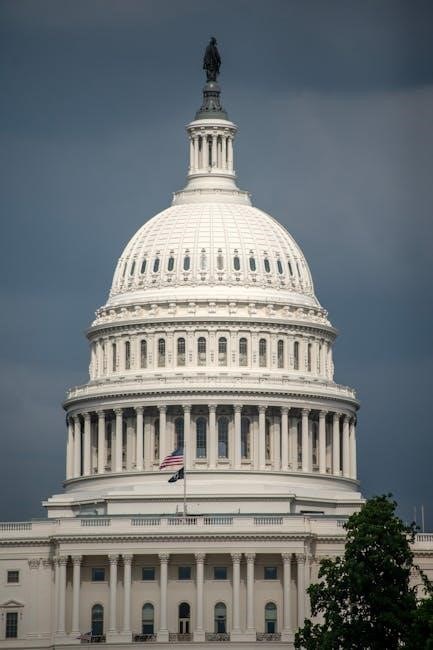This textbook provides a comprehensive analysis of American political institutions, emphasizing institutional design, rational choice theory, and collective action problems to explain the system’s structure and functionality.
Overview of the Book
The Logic of American Politics is a comprehensive textbook that examines the structure, processes, and behavior of American political institutions. The book is divided into three main sections: the nationalization of politics, the institutions of government, and the public’s influence on national policy. It explores key topics such as the Constitution, federalism, civil rights, and liberties, while also delving into the roles of Congress, the presidency, the bureaucracy, and the federal judiciary. The text emphasizes the importance of institutional design, collective action problems, and the interplay between political actors and institutions. It also discusses the impact of political campaigns, elections, parties, interest groups, and the media on shaping public opinion and policy outcomes. By combining historical context with contemporary analysis, the book provides students with a toolkit to understand the logic behind American political institutions and their functionality in a dynamic political landscape.

The Importance of Institutional Design
Institutional design plays a central role in understanding the functioning of the American political system. The book emphasizes how institutions are crafted to address collective action problems, ensuring that political decisions are made effectively. Key concepts such as authority, power, and institutional durability are explored to illustrate how these designs shape governance. The text highlights tools like command, veto, agenda control, voting rules, and delegation, which are essential for grasping how political systems operate. By focusing on institutional design, the book provides a framework for analyzing the strategic behavior of political actors and the challenges they face in resolving collective dilemmas. This approach helps students comprehend the logic behind the structure and processes of American politics, making it easier to navigate the complexities of the system.
Key Concepts: Authority, Power, and Institutional Durability
The book delves into the fundamental concepts of authority, power, and institutional durability, which are crucial for understanding the American political system. Authority refers to the legitimate right to make decisions, while power is the ability to influence outcomes. Institutional durability examines how political structures endure despite challenges. These concepts are interconnected, as authority and power shape institutions, and institutional durability ensures their longevity. The text explains how these elements address collective action problems, providing a framework for analyzing governance. By focusing on these key concepts, the book offers insights into how political systems are designed and maintained, emphasizing the importance of understanding their interplay to grasp the logic of American politics effectively.

The Nationalization of Politics
This section explores the nationalization of American politics, focusing on the Constitution, federalism, and the evolution of civil rights and liberties, shaping the nation’s political landscape.
The Constitution and Its Historical Background
The Constitution, drafted in 1787, is the cornerstone of the U.S. political system, establishing the framework for federalism, separation of powers, and individual rights. Its creation was driven by the need to address collective action problems and unify the states under a coherent system. The Founding Fathers designed it to balance authority and power, ensuring no single entity could dominate. The document’s historical context reflects the lessons learned from the Articles of Confederation and the desire to create a durable institution. Over time, the Constitution has evolved through amendments, adapting to societal changes and political challenges. Understanding its historical background is crucial for grasping how it shapes contemporary American politics and governance. The Constitution’s enduring relevance lies in its ability to reconcile competing interests while maintaining stability and order.
Federalism: Structure and Function

Federalism is a cornerstone of the U.S. political system, dividing power between the federal government and the states. This structure was designed to prevent tyranny by ensuring no single level of government held too much authority. The Constitution outlines the framework, granting the federal government powers such as foreign policy and national defense, while states retain authority over local matters like education and law enforcement. Federalism promotes policy experimentation at the state level, allowing for diverse approaches to governance. However, it also creates challenges, such as balancing uniformity and diversity in laws and policies. Over time, the balance of power has shifted, with the federal government gaining more influence, particularly in areas like commerce and civil rights. Despite these shifts, federalism remains a vital mechanism for managing the complexities of a large, diverse nation, ensuring adaptability and responsiveness to regional needs.
Civil Rights and Liberties in American Politics
Civil rights and liberties are fundamental principles in American politics, ensuring equality and freedom for all citizens. The Constitution, particularly the Bill of Rights, guarantees freedoms such as speech, religion, and assembly, while the 13th and 14th Amendments abolished slavery and established equal protection under the law. The judiciary, especially the Supreme Court, plays a crucial role in interpreting these rights and resolving conflicts. Landmark cases, such as Brown v. Board of Education, have shaped the legal framework for civil rights, combating discrimination and promoting inclusivity. Despite progress, debates persist over issues like affirmative action, voting rights, and LGBTQ+ rights, highlighting the ongoing struggle to balance individual freedoms with societal needs. The interplay between institutional design and civil rights continues to evolve, reflecting the dynamic nature of American democracy and its commitment to justice and equality.
The Institutions of Government
The U.S. government’s institutions—Congress, the presidency, bureaucracy, and judiciary—operate through a system of checks and balances, ensuring accountability while executing their distinct roles in governance and policy implementation.
Congress: Structure, Functions, and Powers
Congress, as the legislative branch, is a bicameral body consisting of the Senate and the House of Representatives. The Senate has 100 members, with two representatives from each state, serving six-year terms. The House of Representatives has 435 members, allocated based on state population, serving two-year terms. Congress’s primary function is to make laws, but it also holds the power to declare war, regulate commerce, and approve presidential appointments. The system of checks and balances ensures Congress can limit the executive and judicial branches. Legislative authority includes budgeting, taxing, and oversight of federal agencies. Congress addresses societal conflicts by creating policies that balance competing interests. Its structure and powers are designed to ensure representation of diverse state and national interests, making it central to American democracy and governance.
The Presidency: Roles and Responsibilities
The presidency is the executive branch of the U.S. government, with the president serving as both the head of state and government. The president’s primary role is to enforce federal laws and act as commander-in-chief of the armed forces. They also conduct foreign policy, negotiating treaties and meeting with international leaders. The president has the power to veto legislation passed by Congress, although Congress can override this veto with a two-thirds majority in both chambers. Additionally, the president appoints federal judges, including Supreme Court justices, and oversees the bureaucracy. The presidency is designed to provide strong leadership while balancing power with Congress through checks and balances. The president’s influence extends to setting the national agenda and responding to crises, making it a central institution in American governance and policy implementation.
The Bureaucracy: Its Role in Governance
The bureaucracy plays a central role in the implementation of public policy, acting as the administrative arm of the executive branch. It is responsible for carrying out the day-to-day operations of government, ensuring that laws and policies are executed effectively. Federal agencies, such as the Department of Defense and the Department of Education, are key components of the bureaucracy, specializing in specific policy areas. These agencies are staffed by civil servants who possess expertise in their fields, enabling them to draft detailed regulations and manage complex programs. The bureaucracy also interacts with Congress and the presidency, providing critical information and implementing legislative directives. While the bureaucracy is essential for governance, its size and complexity often lead to debates about accountability and efficiency. Its role in rulemaking and policy implementation makes it a vital yet controversial institution in American politics.
The Federal Judiciary: Structure and Influence

The federal judiciary is a cornerstone of the American political system, tasked with interpreting the Constitution and ensuring the rule of law. It is structured hierarchically, with the Supreme Court at the apex, followed by circuit courts of appeals, and district courts at the base. The judiciary’s influence extends beyond adjudicating legal disputes, as it plays a pivotal role in shaping public policy through landmark decisions. The Supreme Court, in particular, holds significant power in interpreting laws and resolving constitutional questions, often addressing contentious issues such as civil rights, federalism, and individual liberties. Its decisions have far-reaching implications, impacting societal norms and governmental practices. The judiciary’s independence from the other branches of government allows it to act as a check on their authority, ensuring accountability and upholding the principles of justice and equality. This makes the federal judiciary a powerful and essential institution in American governance.
The Public’s Influence on National Policy

The public shapes national policy through elections, political parties, interest groups, and media, influencing decision-makers and holding them accountable to societal needs and preferences.
Political Campaigns and Elections
Political campaigns and elections are central to American democracy, shaping national policy by determining leadership and legislative priorities. The Logic of American Politics highlights how campaigns serve as mechanisms for voter engagement and accountability. Candidates employ strategies like campaign finance, media outreach, and policy messaging to sway public opinion. Elections, in turn, reflect collective preferences, influencing policy agendas. The textbook emphasizes the role of institutional design, such as voting rules and electoral systems, in shaping campaign dynamics. Recent editions analyze the 2016 and 2024 elections, illustrating how polarization and demographic changes impact outcomes. By examining these processes, the book provides insights into how elections translate public will into governance, emphasizing their critical role in maintaining democratic legitimacy and responsiveness. Understanding these dynamics is essential for grasping how political representation and policy decisions are shaped in America.

Political Parties: Their Role and Impact
Political parties play a pivotal role in shaping American politics, serving as intermediaries between citizens and government. The Logic of American Politics explores how parties structure campaigns, influence voter behavior, and organize governance. They align voters with policy priorities, creating coalitions that define electoral strategies. The two-party system dominates, with Democrats and Republicans representing distinct ideologies. Parties also shape legislative agendas, as their platforms guide policymakers. However, rising polarization has strained party cohesion, leading to internal conflicts. The textbook examines how parties adapt to demographic shifts and ideological changes, impacting their effectiveness in representing diverse constituencies. By analyzing party dynamics, the book highlights their enduring influence on American democracy, despite challenges like factionalism and external pressures. Understanding political parties is crucial for grasping how power is mobilized and maintained in the U.S. political system.

Interest Groups and Their Influence

Interest groups are organizations that seek to influence public policy to benefit their members or causes. In The Logic of American Politics, these groups are analyzed as key players in shaping political outcomes. They employ strategies like lobbying, campaign contributions, and grassroots mobilization to sway decision-makers. By representing diverse sectors—such as businesses, unions, or environmental advocates—they amplify specific voices in policymaking. Their influence extends beyond legislation, impacting public opinion and electoral outcomes. However, critics argue that their power can lead to inequality, as resources and access often favor well-funded groups. The textbook explores how interest groups navigate the political system, balancing competition and collaboration to achieve their goals. Understanding their role is essential for grasping how policies are shaped and whose interests are prioritized in American democracy.

The Media’s Role in Shaping Public Opinion
The media plays a pivotal role in shaping public opinion by framing political issues, setting agendas, and influencing perceptions. In The Logic of American Politics, the media is analyzed as a key intermediary between political institutions and the public. Through various platforms—traditional news outlets, social media, and digital platforms—it disseminates information, often shaping how citizens interpret events. The 24-hour news cycle and the rise of partisan media have intensified this influence, creating echo chambers that reinforce existing beliefs. The textbook highlights how media coverage of elections, such as the 2016 and 2024 presidential races, can significantly impact voter behavior. However, the media’s role is not without challenges, including the spread of misinformation and bias. Understanding the media’s influence is crucial for grasping how public opinion is formed and how it shapes American political outcomes.
The Logic of American Politics concludes by emphasizing the importance of understanding institutional design and collective action in shaping the nation’s political landscape, offering insights into current challenges.
The Significance of Understanding American Political Institutions
Understanding American political institutions is crucial for grasping how the system addresses collective action problems and resolves conflicts. The framework provided by The Logic of American Politics highlights the interplay between institutional design and strategic behavior, offering insights into the challenges of governance. By examining the roles of Congress, the presidency, bureaucracy, and judiciary, the text underscores how these institutions shape policy outcomes; The book emphasizes the importance of concepts like authority, power, and institutional durability in maintaining stability. It also explores how public opinion, political parties, and interest groups influence the system. This analytical approach equips students to critically evaluate the logic behind American political processes and their implications for democracy. The text’s focus on institutional design helps explain why certain policies succeed or fail, providing a foundation for understanding the complexities of American governance in a polarized era.
